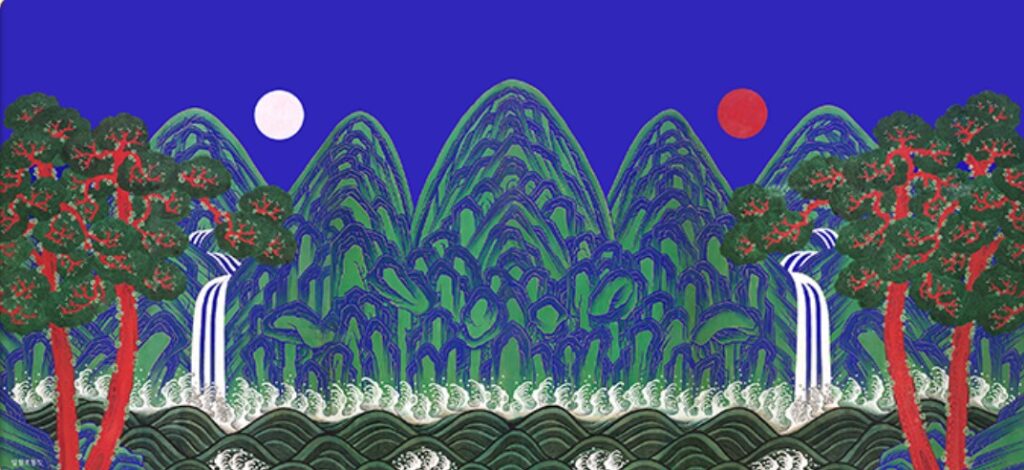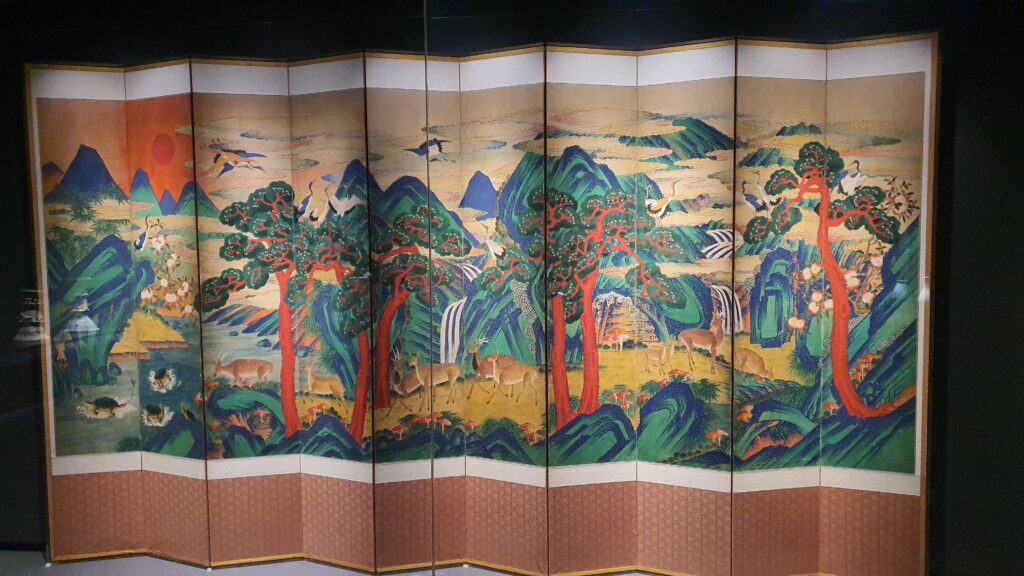The K-pop Demon Hunters (KDH) music video Golden highlights a traditional Korean folding screen.
In the MV, you see a red sun, a blue moon, five peaks, waterfalls, waves, and pine trees.
This majestic design comes from the royal artwork called Ilwol Obongdo (Sun, Moon, and Five Peaks).

🏯 What is Ilwol Obongdo?
Ilwol Obongdo is a royal folding screen placed behind the king’s throne during the Joseon Dynasty.
It symbolizes the authority of the king and the harmony between heaven, earth, and nature.

| Element | Meaning |
|---|---|
| Sun and Moon | Yin and yang, showing that the king follows the cosmic order |
| Five Peaks | Five directions and the Five Elements theory, representing protection of the state |
| Waterfalls & Waves | The king’s benevolence spreading to the people |
| Pine Trees | Unchanging loyalty and eternal royal power |
It was not just a landscape painting but a powerful visual device connecting the king with the universe.
Every royal hall—such as Geunjeongjeon Hall in Gyeongbokgung Palace—had Ilwol Obongdo behind the throne,
so even in the king’s absence, this painting still represented royal authority.
🎥 How was it used in KDH Golden MV?
The Golden MV blends K-pop aesthetics with traditional Korean art.
By reinterpreting Ilwol Obongdo, the MV created a stage that feels majestic, authoritative, and deeply rooted in Korean heritage.
- Red sun & blue moon → creates a mystical, transcendent atmosphere
- Five mountain peaks & waterfalls → enhances the grandeur of the set
- Symbol of royal power repurposed as a K-pop visual identity
In other words, what once symbolized the king’s authority now serves as a visual motif linking K-pop to Korean cultural identity on a global stage.
🖼 A Related Royal Folding Screen: Sipjangsaengdo
Another royal screen with a similar style is the Sipjangsaengdo (十長生圖, “Ten Symbols of Longevity”).
This screen depicts 10 symbols of immortality and longevity: the sun, mountains, clouds, pine trees, waterfalls, turtles, cranes, deer, elixir plants (bullocho), and rocks.
Unlike Ilwol Obongdo, which focuses on royal power, Sipjangsaengdo expresses a wish for health, long life, and prosperity.
Interestingly, historical records show that at the beginning of the New Year, the king presented Sipjangsaengdo as a gift to his court officials,
and it was widely used for royal banquets and ceremonies.
The painting below is a famous Sipjangsaengdo donated to the Korean state by the late Samsung Chairman Lee Kun-hee,
now part of the National Museum of Korea’s collection.

Both Ilwol Obongdo and Sipjangsaengdo share vivid primary colors, symbolic composition, and a decorative yet flat style,
showing the unique aesthetics of Joseon Dynasty royal folding screens.
- Ilwol Obongdo → symbol of royal authority and cosmic order
- Sipjangsaengdo → symbol of longevity and blessings
They serve different purposes but share a similar visual language of traditional Korean court art.
🎯 Final Thoughts
The Ilwol Obongdo in KDH’s Golden MV is a perfect example of how traditional royal art is reinterpreted in contemporary K-pop culture.
Meanwhile, Sipjangsaengdo shows how similar folding screens were used to express wishes for longevity and good fortune,
illustrating the diversity and richness of Korean palace art.
Seeing these motifs revived on a modern global stage highlights how heritage can inspire new cultural expressions—
bridging the past and the present in a visually powerful way.